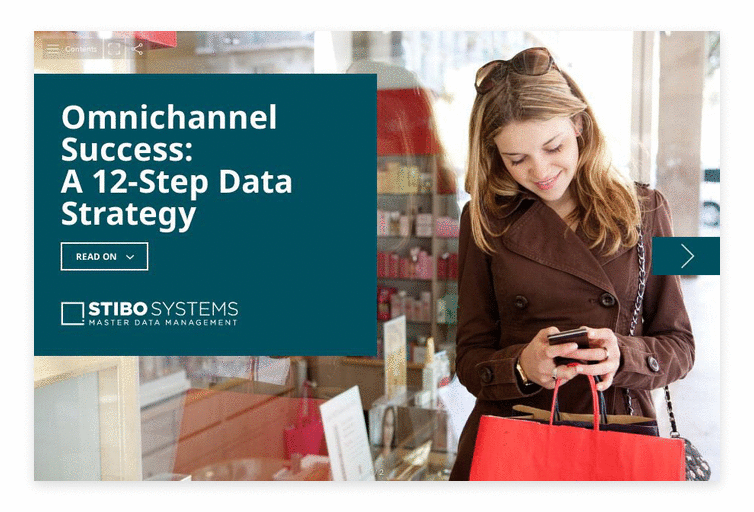In today's digital age, customers expect seamless and personalized interactions across multiple channels. This shift has given rise to the concept of omnichannel customer experience, where businesses strive to create a unified and cohesive journey for their customers, regardless of the channel they choose to engage with.
In this blog post, we will explore the fundamentals of omnichannel customer experience, its benefits and strategies to implement it successfully. Further, we dive into the world of omnichannel and discover how it can revolutionize your customer interactions, drive loyalty and elevate your brand in the competitive landscape.

Understanding omnichannel customer experience
Omnichannel customer experience is a customer-centric approach that focuses on providing a seamless and integrated experience across all channels and touchpoints. It recognizes that customers interact with businesses through multiple channels, such as websites, mobile apps, social media, physical stores, call centers and more.
Key principles of omnichannel customer experience:
-
Channel integration: Omnichannel aims to break down channel silos and create a unified experience. It ensures that customers can switch between channels without losing context or starting from scratch.
-
Consistency: Regardless of the channel, customers expect consistent messaging, branding and service. Omnichannel ensures that the same level of quality and experience is maintained across all touchpoints.
-
Personalization: Understanding customer preferences and behaviors is crucial for delivering personalized experiences. Omnichannel leverages customer data to provide tailored recommendations, promotions and interactions.
-
Convenience: Omnichannel emphasizes convenience by making it easy for customers to interact, purchase and engage with a business through their preferred channels. It reduces friction and offers a seamless experience.
Differences from other customer experience approaches:
-
Multichannel: While multichannel focuses on providing multiple channels for customer interaction, it often lacks integration and consistency. Omnichannel takes it a step further by ensuring seamless experiences and channel integration.
-
Cross-channel: Cross-channel also involves multiple channels, but interactions tend to be independent of each other. In contrast, omnichannel emphasizes integration and continuity across channels.
-
Single-channel: Single-channel experiences are limited to a specific channel, such as an online store or physical location. Omnichannel expands beyond a single channel to encompass the entire customer journey.
Omnichannel customer experience recognizes that customers expect a connected and cohesive experience across all channels. By embracing this approach, businesses can meet customer expectations, build stronger relationships and drive long-term loyalty.
What are the benefits of omnichannel customer experience?
Implementing an effective omnichannel customer experience strategy can bring numerous benefits to businesses. Here are some advantages they can gain:
-
Increased customer satisfaction: Omnichannel customer experiences provide seamless and consistent interactions, ensuring that customers receive the same level of service across all channels. This leads to higher customer satisfaction as they can easily find information, make purchases and resolve issues, regardless of the channel they choose.
-
Improved customer loyalty: By offering a cohesive and personalized experience, businesses can enhance customer loyalty. Omnichannel strategies enable businesses to understand customer preferences and deliver targeted promotions, recommendations and rewards, fostering stronger connections and encouraging repeat purchases.
-
Higher conversions and sales: Omnichannel experiences reduce friction in the customer journey. Customers can seamlessly move between channels, leading to a smoother path to purchase. This convenience and flexibility increase conversion rates and drive higher sales.
-
Enhanced brand reputation: Providing a consistent and exceptional omnichannel experience contributes to a positive brand reputation. Customers appreciate businesses that make their interactions effortless and enjoyable across all touchpoints. Positive word-of-mouth and online reviews can further enhance the brand's reputation and attract new customers.
-
Deeper customer insights: Omnichannel strategies generate a wealth of customer data. By integrating data from various channels, businesses can gain valuable insights into customer behaviors, preferences and buying patterns. These insights enable businesses to make informed decisions, personalize marketing efforts and optimize their overall customer experience.
-
Competitive advantage: In today's competitive landscape, offering an exceptional omnichannel experience sets businesses apart from their competitors. Customers are more likely to choose brands that provide a seamless and personalized experience, leading to a competitive edge and differentiation in the market.
-
Increased operational efficiency: While implementing omnichannel strategies may require initial investment and effort, it can lead to long-term operational efficiency. By streamlining processes, integrating systems and consolidating data, businesses can reduce redundancies, improve inventory management and optimize resource allocation.
-
Future-proofing the business: As customer expectations continue to evolve, an effective omnichannel strategy future-proofs the business. By adapting to changing customer behaviors and preferences, businesses can stay ahead of the curve, remain relevant and sustain growth in a rapidly evolving digital landscape.
In summary, implementing an effective omnichannel customer experience strategy offers numerous benefits to businesses. From increased customer satisfaction and loyalty to higher conversions and an enhanced brand reputation, businesses can gain a competitive edge and drive long-term success by prioritizing and delivering exceptional omnichannel experiences.
WHITE PAPER
Strategies for a Superior Omnichannel Experience
How to leverage your data to win
customer loyalty in retail.

Key elements of a successful omnichannel strategy
A successful omnichannel strategy encompasses several key elements that work together to deliver a seamless and personalized customer experience. Here are the essential components of an effective omnichannel customer experience strategy:
-
Seamless integration across channels: Integration is vital to ensure a consistent experience across all channels. It involves connecting different systems, data sources and touchpoints to enable smooth transitions as customers move between channels. This integration ensures that customers can access their information, preferences and purchase history regardless of the channel they engage with.
-
Personalized interactions: Personalization is at the core of an effective omnichannel strategy. By leveraging customer data, businesses can deliver tailored experiences, recommendations and offers that resonate with individual preferences and needs. Personalization enhances engagement, customer satisfaction and loyalty.
-
Consistent messaging: Consistency in messaging is crucial for brand recognition and a unified customer experience. Whether it is through advertising, social media or customer support, maintaining consistent messaging and branding across all channels builds trust and reinforces the brand identity.
-
Unified customer profiles: Creating unified customer profiles consolidates data from different channels into a single view. It allows businesses to have a holistic understanding of their customers, including their preferences, purchase history and interactions across channels. Unified customer profiles enable personalized experiences and provide valuable insights for targeted marketing campaigns.
-
Frictionless transitions between touchpoints: Seamlessly transitioning between channels is essential for a positive customer experience. Customers should be able to start an interaction on one channel and effortlessly continue it on another without having to repeat information. For example, a customer may research a product online and then visit a physical store to make the purchase with all relevant information readily available.
-
Technology and infrastructure: Implementing the right technology infrastructure is crucial for supporting an omnichannel strategy. This includes customer relationship management (CRM) systems, data integration tools, analytics platforms and other solutions that enable data sharing, analysis and seamless customer interactions across channels.
-
Organizational alignment: Successful implementation of an omnichannel strategy requires alignment and collaboration across different departments and teams within the organization. Cross-functional coordination ensures that all customer touchpoints are synchronized and that the entire organization is working towards delivering a unified customer experience.
-
Continuous optimization: An effective omnichannel strategy is not static but evolves with changing customer expectations and emerging technologies. Continuous monitoring, analysis and optimization of the customer journey and performance metrics are vital to identify areas for improvement and implement necessary changes.
By focusing on these key elements, businesses can create an effective omnichannel strategy that delivers a cohesive, personalized and seamless customer experience across all channels. This, in turn, drives customer satisfaction, loyalty and business growth.
Implementing an omnichannel approach
Implementing an effective omnichannel customer experience strategy requires careful planning and execution. Here are practical steps that businesses can follow to implement an omnichannel approach:
-
Define your objectives: Clearly articulate your goals and objectives for implementing an omnichannel strategy. Identify what you aim to achieve, such as increased customer satisfaction, improved sales or enhanced brand loyalty. This will guide your strategy development and help measure success.
-
Understand customer journeys: Gain insights into your customers' journeys across channels. Map out the touchpoints and interactions they have with your brand, both online and offline. Identify pain points, areas for improvement and opportunities to deliver a seamless and consistent experience.
-
Integrate data silos: Break down data silos by integrating customer data from different channels and touchpoints. Centralize customer information in a unified database or CRM system. This allows for a holistic view of customers and facilitates personalized interactions.
-
Select the right technologies: Choose the appropriate technologies to support your omnichannel strategy. This may include CRM systems, customer data platforms (CDPs), marketing automation tools and analytics solutions. Evaluate the capabilities of these technologies and ensure they can integrate and share data effectively.
-
Align organizational structure: Ensure your organization is structured to support an omnichannel approach. Foster cross-department collaboration and communication to ensure consistent messaging and experiences. Align teams responsible for marketing, sales, customer service and IT to work together towards a unified customer experience.
-
Train and empower staff: Provide training and resources to your employees to understand and deliver on the omnichannel vision. Equip them with the knowledge and tools to provide personalized and consistent experiences across channels. Encourage a customer-centric mindset throughout the organization.
-
Optimize processes: Streamline and optimize processes to enable a seamless customer experience. Remove any barriers or friction points that may impede smooth transitions between channels. Simplify purchasing processes, improve inventory visibility and ensure efficient order fulfillment.
-
Monitor and measure performance: Establish key performance indicators (KPIs) to measure the success of your omnichannel strategy. Track metrics such as customer satisfaction, sales conversion rates, customer lifetime value and channel performance. Regularly analyze data and feedback to identify areas for improvement and make data-driven decisions.
-
Embrace change management: Implementing an omnichannel strategy may require organizational changes and shifts in mindset. Embrace change management practices to gain buy-in from stakeholders, address resistance and ensure a smooth transition. Communicate the benefits of the omnichannel approach and provide support throughout the process.
-
Continuously evolve: An omnichannel strategy is not a one-time implementation but an ongoing process. Stay updated on emerging technologies, customer trends and industry best practices. Continuously adapt and refine your strategy to meet evolving customer expectations and deliver exceptional experiences.
By following these practical steps, businesses can lay a solid foundation for implementing an effective omnichannel customer experience strategy.
Overcoming challenges in omnichannel implementation
Implementing an omnichannel customer experience strategy can present various challenges for businesses. Here are some common obstacles and strategies to overcome them:
-
Organizational silos: Siloed departments and lack of cross-functional collaboration can hinder the seamless integration of channels. Break down silos by fostering open communication, establishing shared goals and promoting a customer-centric mindset across the organization. Encourage collaboration and provide resources for cross-departmental teams to work together effectively.
-
Legacy systems and infrastructure: Outdated or incompatible systems may pose challenges in achieving channel integration and data sharing. Evaluate your existing technology infrastructure and identify gaps. Gradually modernize systems or implement middleware solutions that facilitate data integration and enable communication between different systems.
-
Data privacy and security: Collecting and managing customer data across channels requires strict adherence to data privacy regulations and robust security measures. Ensure compliance with applicable laws and regulations such as GDPR or CCPA. Implement secure data storage, encryption and access controls. Communicate your commitment to data privacy and security to build trust with customers.
-
Customer data fragmentation: Customer data fragmentation across multiple systems and touchpoints can hinder the creation of a unified view of customers. Implement a CDP or centralized database to aggregate and consolidate customer data from various sources. This enables a single, comprehensive customer profile that can be accessed across channels.
-
Consistent branding and messaging: Maintaining consistent branding and messaging across channels is essential for a unified customer experience. Develop brand guidelines and communication protocols that ensure consistent visuals, tone and messaging. Provide training and resources to employees to ensure they understand and adhere to the brand standards.
-
Change management: Implementing an omnichannel strategy often involves significant organizational changes and may encounter resistance. Develop a change management plan that includes clear communication, stakeholder involvement and employee training. Highlight the benefits and long-term value of the strategy to gain support and engagement from employees at all levels.
-
Customer expectations: Meeting ever-increasing customer expectations for seamless experiences can be challenging. Regularly assess and understand customer preferences, behaviors and pain points through customer feedback, surveys and data analysis. Use this insight to continuously improve and optimize the omnichannel experience.
-
Measuring and analyzing data: Having access to a vast amount of data can be overwhelming. Define KPIs aligned with your omnichannel strategy and use analytics tools to measure and analyze relevant metrics. Monitor customer feedback, track conversion rates and assess the impact of your omnichannel initiatives. Use data-driven insights to make informed decisions and drive continuous improvement.
By proactively addressing these challenges, businesses can overcome obstacles in implementing an omnichannel customer experience strategy. With careful planning, stakeholder alignment and a customer-centric approach, businesses can deliver seamless experiences and reap the rewards of increased customer satisfaction, loyalty and business growth.
CHECKLIST
Omnichannel Success: A 12-Step Data Strategy

Personalization in omnichannel experiences
Personalization plays a pivotal role in delivering exceptional omnichannel customer experiences. It involves tailoring interactions, recommendations and offers to individual customer preferences and needs. By leveraging customer data collected from various touchpoints, businesses can create personalized experiences. Here are some strategies for collecting and leveraging customer data to provide effective personalization in omnichannel experiences:
-
Data collection: Collect customer data across channels and touchpoints. This includes information such as purchase history, browsing behavior, preferences, demographics and interactions with customer service. Use both implicit data (collected passively) and explicit data (provided by customers) to gain a comprehensive understanding of individual preferences.
-
Centralized customer profiles: Consolidate customer data into unified profiles that can be accessed and utilized across channels. CRM systems or CDPs can help create centralized profiles that contain a complete view of each customer's interactions and preferences.
-
Segmentation and targeting: Segment customers based on common characteristics, behaviors or preferences. This allows for more targeted and relevant messaging and experiences. Develop customer personas and tailor content, offers and recommendations to each segment. Consider factors like demographics, purchase history and psychographic traits to ensure accurate targeting.
-
Real-time personalization: Utilize real-time data to personalize customer experiences on the fly. By analyzing customer behavior and preferences in real-time, businesses can deliver dynamic content, product recommendations and offers that are highly relevant and timely. This can be achieved through machine learning algorithms and real-time decisioning engines.
-
Behavioral tracking and analysis: Monitor and analyze customer behavior across channels to identify patterns and trends. Track interactions, click-through rates, purchase history and other relevant metrics to understand customer preferences and intent. Use this information to personalize the customer journey and deliver targeted content and offers.
-
Personalized recommendations: Leverage customer data and algorithms to provide personalized product recommendations. Use past purchase history, browsing behavior and contextual information to suggest relevant products or services. Implement recommendation engines that dynamically adapt to customer preferences and behaviors.
-
Contextual messaging: Tailor messaging and content based on the customer's context and channel of interaction. Deliver consistent and relevant messages across channels, considering factors like location, device and customer history. Personalized messaging enhances engagement and creates a cohesive customer experience.
-
Omnichannel retargeting: Implement retargeting strategies to engage customers across channels. For example, if a customer abandons their shopping cart on a website, retarget them with a personalized email or mobile notification to remind them of the items they left behind. Coordinate retargeting efforts across channels to ensure consistent messaging and maximize impact.
-
Continuous optimization: Regularly analyze customer data, feedback and performance metrics to refine and improve personalization efforts. Use A/B testing and experimentation to evaluate the effectiveness of different personalization strategies. Continuously adapt and optimize personalization techniques based on insights gained from data analysis.
By implementing these strategies, businesses can harness the power of personalization in delivering exceptional omnichannel customer experiences. Personalization creates deeper customer connections, increases engagement and drives customer loyalty, ultimately leading to improved business outcomes and long-term success.
How master data management can support personalization in omnichannel experiences
Master data management (MDM) plays a critical role in supporting personalization in omnichannel experiences. MDM involves the consolidation, integration and management of an organization's core data assets to ensure accuracy, consistency and reliability. Here is how MDM can support personalization in omnichannel experiences:
-
Unified customer profiles: MDM enables the creation of unified customer profiles by consolidating customer data from various sources and channels. By establishing a single, accurate and comprehensive view of each customer, MDM provides a foundation for personalized experiences across channels. This unified profile includes customer demographics, purchase history, preferences and other relevant data, allowing businesses to understand individual customer needs and deliver targeted interactions.
-
Data quality and consistency: MDM ensures data quality and consistency by implementing data governance policies and data cleansing processes. It addresses data issues such as duplicate records, inconsistencies and inaccuracies, which are common in organizations with disparate data sources. Reliable and accurate customer data is essential for effective personalization, as it forms the basis for personalized recommendations, offers and experiences.
-
Cross-channel data integration: MDM facilitates the integration of data from various channels and touchpoints. It enables the seamless exchange and synchronization of customer data across systems, ensuring that customer interactions and preferences are captured accurately and in real-time. This integrated data forms the foundation for delivering personalized experiences consistently across channels, allowing businesses to provide tailored recommendations and offers based on the customer's complete journey.
-
Contextual insights: MDM enables the aggregation and analysis of customer data from multiple channels to gain contextual insights. By understanding customer behavior, preferences and intent across channels, businesses can personalize interactions based on the specific context of each touchpoint. MDM supports the correlation of data from different sources to derive meaningful insights, enabling businesses to deliver relevant and timely experiences to customers.
-
Personalized marketing campaigns: MDM supports the execution of personalized marketing campaigns by providing a single source of truth for customer data. Marketers can leverage MDM capabilities to segment customers based on their preferences, behaviors and demographics, and create targeted campaigns across channels. MDM ensures that customer data is accurate, up-to-date and synchronized, enabling the delivery of personalized messages, offers and content that resonate with individual customers.
-
Real-time personalization: MDM, combined with real-time data processing and decisioning capabilities, enables real-time personalization. By integrating MDM with real-time analytics and decision-making engines, businesses can deliver personalized experiences in the moment of interaction. Real-time personalization allows for dynamic content, product recommendations and offers that are tailored to the customer's current context and needs.
-
Compliance and data privacy: MDM helps organizations ensure compliance with data privacy regulations and protect customer data. It facilitates the implementation of data governance and security measures to safeguard sensitive customer information. MDM provides controls for data access, data masking and data anonymization, ensuring that personalization efforts are conducted in a privacy-conscious manner.
By leveraging master data management, businesses can establish a solid foundation for personalization in omnichannel experiences. MDM enables the creation of unified customer profiles, ensures data quality and consistency, supports cross-channel data integration and facilitates real-time personalization. With reliable and comprehensive customer data, organizations can deliver targeted, relevant and personalized experiences that enhance customer engagement, satisfaction and loyalty across all channels.
EXPLORE
Master Data Management for Retailers






































































































































































































